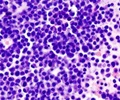When devising a treatment plan for Leukemia , doctors rely on indicators to decide how aggressive the cancer is likely to be, including how the
When devising a treatment plan for Leukemia , doctors rely on indicators to decide how aggressive the cancer is likely to be, including how the cancer cells look under a microscope, the patient’s age, and disease history. However, for some patients, those indicators are not enough to place them in a high-risk or low-risk group. Doctors may be left guessing which treatments to try.
Researchers have uncovered 133 genes that point to the most dangerous strains of adult leukemia. They say that this discovery may help doctors pick the best treatment for their patients, specifically by identifying cancer patients who need aggressive therapy.Researchers have determined the minimal numbers of genes needed to identify important gene clusters linked to leukemia. In addition, they identified a unique cluster with a distinctive gene-expression that includes cases of leukemia with a poor treatment outcome.
Researchers say they also found some of the genes activated differently between the high-risk and intermediate-risk groups that were not previously known to be involved in acute myeloid leukemia. Studying these genes and their proteins could lead to new treatments for the disease, investigators conclude.










